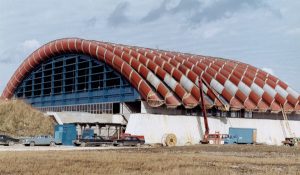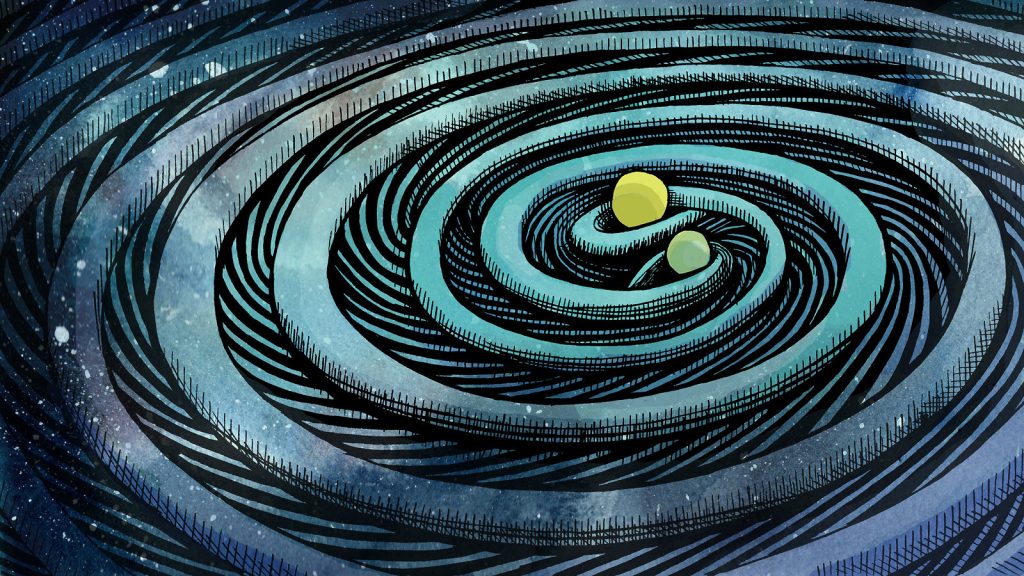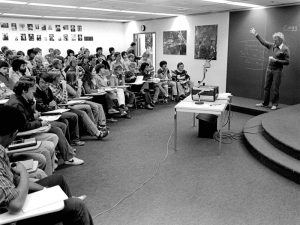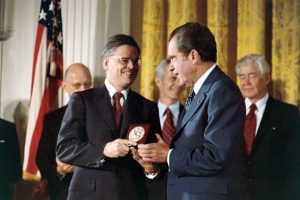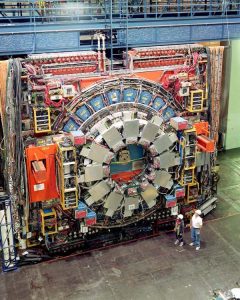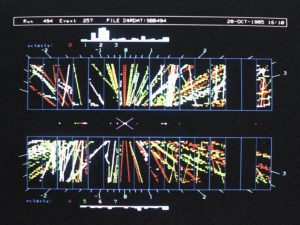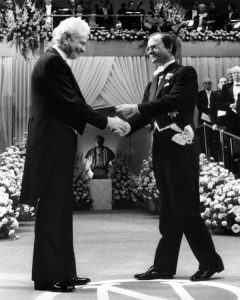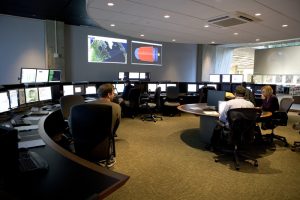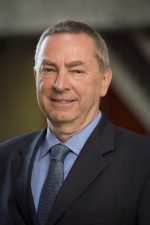It was late 1972 and the Meson Lab was just working on its first beam transport. I was a new crew chief, having just joined the lab, and a man named John was my assistant. We were operating from the MS-2 service building with the roaring power supplies. It was about 8 p.m. The Main Ring had just gone down and the Main Control Room gave an estimate of one hour. (Everything only took one hour back then, until they gave the next updated estimate of one hour!)
As I sat and fiddled with the MAC-16 control computer to see what it would do, John sat with his feet propped up on a desk watching “The Honeymooners” TV show starring Jackie Gleason on a small black and white monitor. I looked up to see a gentleman walking towards me wearing a beret and wearing a top coat. He came over and asked what I was doing, and I said I was trying to learn all about the computer. Nowadays it would be called hacking!
I mentioned the ring was down for an hour. He thanked me, turned and walked back toward the door, glancing at John as he walked past. I asked John who the gentleman was, and John just shrugged. “No idea” he said.
When I came in for my shift the next day, my boss, Jim, called me in to his office. He looked at me with a terse smile and said, “Dr. Wilson was happy to see you trying to understand the control system, but for crying out loud, don’t let John watch “The Honeymooners” when the director is there!”
That event was my introduction to Dr. Robert R. Wilson, and I spoke with him numerous times after that.
Paul Czarapata is the deputy head of the Accelerator Division.
Editor’s note: Earlier today, the Nobel committee selected Rainer Weiss and the pair of Barry Barish and Kip Thorne for the 2017 Nobel Prize in physics for their contributions to the Laser Interferometer Gravitational-wave Observatory (LIGO). Barish has a long history with Fermilab, having led the E-21A experiment in the 1970s, which studied neutrinos at very high energies. He has also been at the forefront of the International Linear Collider effort, which Fermilab has contributed to over the past decade. Rainer Weiss, a professor of physics at MIT, has been a collaborator on Fermilab’s Holometer experiment since its inception in 2009. The detection of gravitational waves in 2015 was a landmark discovery, and Fermilab congratulates the winners of the Nobel Prize and the entire LIGO collaboration.
After being passed up for the honor last year, three scientists who made essential contributions to the LIGO collaboration have been awarded the 2017 Nobel Prize in Physics.
Rainer Weiss will share the prize with Kip Thorne and Barry Barish for their roles in the discovery of gravitational waves, ripples in space-time predicted by Albert Einstein. Weiss and Thorne conceived of LIGO, and Barish is credited with reviving the struggling experiment and making it happen.
“I view this more as a thing that recognizes the work of about 1000 people,” Weiss said during a Q&A after the announcement this morning. “It’s really a dedicated effort that has been going on, I hate to tell you, for as long as 40 years, people trying to make a detection in the early days and then slowly but surely getting the technology together to do it.”
Another founder of LIGO, scientist Ronald Drever, died in March. Nobel Prizes are not awarded posthumously.
According to Einstein’s general theory of relativity, powerful cosmic events release energy in the form of waves traveling through the fabric of existence at the speed of light. LIGO detects these disturbances when they disrupt the symmetry between the passages of identical laser beams traveling identical distances.
The setup for the LIGO experiment looks like a giant L, with each side stretching about 2.5 miles long. Scientists split a laser beam and shine the two halves down the two sides of the L. When each half of the beam reaches the end, it reflects off a mirror and heads back to the place where its journey began.
Normally, the two halves of the beam return at the same time. When there’s a mismatch, scientists know something is going on. Gravitational waves compress space-time in one direction and stretch it in another, giving one half of the beam a shortcut and sending the other on a longer trip. LIGO is sensitive enough to notice a difference between the arms as small as 1000th the diameter of an atomic nucleus.
Scientists on LIGO and their partner collaboration, called Virgo, reported the first detection of gravitational waves in February 2016. The waves were generated in the collision of two black holes with 29 and 36 times the mass of the sun 1.3 billion years ago. They reached the LIGO experiment as scientists were conducting an engineering test.
“It took us a long time, something like two months, to convince ourselves that we had seen something from outside that was truly a gravitational wave,” Weiss said.
LIGO, which stands for Laser Interferometer Gravitational-Wave Observatory, consists of two of these pieces of equipment, one located in Louisiana and another in Washington state.
The experiment is operated jointly by Weiss’s home institution, MIT, and Barish and Thorne’s home institution, Caltech. The experiment has collaborators from more than 80 institutions from more than 20 countries. A third interferometer, operated by the Virgo collaboration, recently joined LIGO to make the first joint observation of gravitational waves.
Editor’s note: This article originally appeared in Symmetry.
Fermilab directors receive formal recognition for their pioneering science, an important groundbreaking takes place, and a new education program takes off in October. What else in Fermilab’s history happened in October?
New lab director Leon Lederman was passionate about science education. He started Saturday Morning Physics, a program in which Fermilab scientists teach a series of physics classes to local high school students. The first course was held in October 1980.
The Main Ring was the final and largest component of the lab’s accelerator system. This underground ring, which was about four miles around, used magnets to accelerate protons to very high speeds. These protons, and other beams derived from them, were then used in the four experimental areas. The Oct. 3, 1969, groundbreaking marked the beginning of the construction of the tunnel that would hold the ring.
On Oct. 3, 1973, President Richard Nixon announced that lab director Robert R. Wilson would be awarded the National Medal of Science for “unusual ingenuity in designing experiments to explore the fundamental particles of matter and in designing and constructing the machines to produce the particles, culminating in the world’s most powerful particle accelerator.”
The Tevatron proton-antiproton collider was dedicated on Oct. 11, 1985.
CDF, the Collider Detector at Fermilab, was designed to study the proton-antiproton collisions created by the Tevatron. The design of CDF began in January 1978 with the formation of the Colliding Detector Facility, headed by Alvin Tollestrup. Construction of CDF began on July 1, 1982, and on Oct. 13, 1985, it detected its first particle collisions. CDF, an international collaboration between institutions in the United States, Japan, and Italy, would become one of Fermilab’s flagship experiments and at its height would have more than 600 participants.
On the morning of Oct. 19, 1988, lab director Leon Lederman received a call informing him that he and his colleagues Melvin Schwartz and Jack Steinberger had won the 1988 Nobel Prize in physics for their 1962 discovery of the muon neutrino at the Brookhaven National Laboratory AGS accelerator.
The LHC Remote Operations Center in Fermilab’s Wilson Hall was dedicated on Oct. 22, 2007, further cementing the partnership between Fermilab and CERN, Europe’s particle physics laboratory. About 600 U.S. scientists work on CERN’s CMS experiment, and the center allows them to work on the experiment remotely.
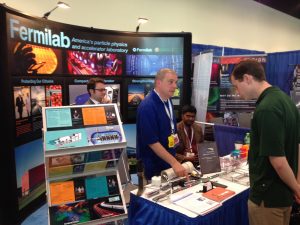
Derek Plant demonstrates his award-winning Ghost Train Generator at the National Innovation Summit in May. In the background are Fermilab’s Aaron Sauers (left) and Charles Thangaraj. Photo courtesy of Cherri Schmidt
The damsel in distress, tied up and left on the railroad tracks, is one of the oldest and most clichéd cinema tropes.
Browsing YouTube late at night, Fermilab Technical Specialist Derek Plant found that this clichéd crime has connections to real, contemporary accidents that happen far more than they should. The videos all begin the same way: a large vehicle — a bus, semi or other low-clearance vehicle — is stuck on a railroad crossing. In the end, the train crashes into the stuck vehicle, destroying it and sometimes even derailing the train. According to the Federal Railroad Administration, every year hundreds of vehicles meet this grisly fate by trains, which can take over a mile to stop.
“I was just surprised at the number of these that I found,” Plant said. “For every accident that’s videotaped, there are probably many more.”
Inspired by a workplace safety class that preached a principle of minimizing the impact of accidents, Derek set about looking for solutions to the problem of trains hitting stuck vehicles. Railroad tracks are elevated for proper drainage, and the humped profile of many crossings can cause a vehicle to bottom out.
“Theoretically, we could lower all the crossings so that they’re no longer a hump. But there are 200,000 crossings in the United States,” Plant said. “Railroads and local governments are trying hard to minimize the number of these crossings by creating overpasses, or elevating roadways. That’s cost-prohibitive, and it’s not going to happen soon.”
Other solutions, such as re-engineering the suspension on vehicles likely to get stuck, seemed equally improbable.
After studying how railroad signaling systems work, Plant came up with an idea: to fake the presence of a train. His invention was developed in his spare time using techniques and principles he learned over his almost two decades at Fermilab. It is currently in the patent application process and being written and filed by Fermilab’s Office of Technology Transfer.
“If you cross over a railroad track and you look down the tracks, you’ll see red or yellow or green lights,” he said. “Trains have traffic signals too.”
These signals are tied to signal blocks — segments of the tracks that range from a mile to several miles in length. When a train is on the tracks, its metal wheels and axle connect both rails, forming an electric circuit through the tracks to trigger the signals. These signals inform other trains not to proceed while one train occupies a block, avoiding pileups.
Plant thought, “What if other vehicles could trigger the same signal in an emergency?” By faking the presence of a train, a vehicle stuck on the tracks could give advanced warning for oncoming trains to stop and stall for time. Hence the name of Plant’s invention: the Ghost Train Generator.
To replicate the train’s presence, Plant knew he had to create a very strong electric current between the rails. The most straightforward way to do this is with massive amounts of metal, as a train does. But for the Ghost Train Generator to be useful in a pinch, it needs to be small, portable and easily applied. The answer to achieving these features lies in strong magnets and special wire.
“Put one magnet on one rail and one magnet on the other and the device itself mimics — electrically — what a train would look like to the signaling system,” he said. “In theory, this could be carried in vehicles that are at high risk for getting stuck on a crossing: semis, tour buses and first-response vehicles,” Plant said. “Keep it just like you would a fire extinguisher — just behind the seat or in an emergency compartment.”
Once the device is deployed, the train would receive the signal that the tracks were obstructed and stop. Then the driver of the stuck vehicle could call for emergency help using the hotline posted on all crossings.
Plant compares the invention to a seatbelt.
“Is it going to save your life 100 percent of the time? Nope, but smart people wear them,” he said. “It’s designed to prevent a collision when a train is more than two minutes from the crossing.”
And like a seatbelt, part of what makes Plant’s invention so appealing is its simplicity.
“The first thing I thought was that this is a clever invention,” said Aaron Sauers from Fermilab’s technology transfer office, who works with lab staff to develop new technologies for market. “It’s an elegant solution to an existing problem. I thought, ‘This technology could have legs.’”
The organizers of the National Innovation Summit seem to agree. In May, Fermilab received an Innovation Award from TechConnect for the Ghost Train Generator. The invention will also be featured as a showcase technology in the upcoming Defense Innovation Summit in October.
The Ghost Train Generator is currently in the pipeline to receive a patent with help from Fermilab, and its prospects are promising, according to Sauers. It is a nonprovisional patent, which has specific claims and can be licensed. After that, if the generator passes muster and is granted a patent, Plant will receive a portion of the royalties that it generates for Fermilab.
Fermilab encourages a culture of scientific innovation and exploration beyond the field of particle physics, according to Sauers, who noted that Plant’s invention is just one of a number of technology transfer initiatives at the lab.
Plant agrees — Fermilab’s environment help motivate his efforts to find a solution for railroad crossing accidents.
“It’s just a general problem-solving state of mind,” he said. “That’s the philosophy we have here at the lab.”
Nigel Lockyer has been reappointed as the director of the U.S. Department of Energy’s Fermi National Accelerator Laboratory. During his first four years as leader of the world-renowned laboratory he helped enhance its international scientific leadership, including the launch of a pioneering international particle physics project hosted by Fermilab.
Lockyer’s second five-year term, which begins Sept. 3, 2018, comes as Fermilab begins building its flagship project that will send neutrino particles underground from Illinois to South Dakota to unlock new insights into the origins of the universe. The lab is also a leader in the Large Hadron Collider at CERN in Switzerland while serving as the home of groundbreaking experiments conducted by scientists from around the world.
“For decades, scientists working at Fermilab have made major discoveries that have greatly illuminated the nature of matter and the universe. Under Nigel’s outstanding leadership, Fermilab is not only continuing many of its important ongoing projects, but has embarked upon a new ambitious research agenda for the coming years that will enable further profound discoveries,” said Robert J. Zimmer, president of the University of Chicago and chair of the Board of Directors of Fermi Research Alliance LLC.
The Fermi Research Alliance, which was formed in 2006, is a joint partnership of the University of Chicago and the Universities Research Association Inc. Together they manage Fermilab under a contract with the Department of Energy. Fermilab’s operations include a powerful complex of particle accelerators and sophisticated experiments to study the nature of matter, energy, space and time, with more than 4,500 scientists from 50 countries using the research facilities annually.
“On behalf of the Universities Research Association, Nigel has been an extraordinary leader, and we join the University of Chicago in enthusiastically supporting this reappointment,” said Lou Anna K. Simon, chair of the Universities Research Association and vice chair of Fermi Research Alliance LLC.
During his first term, Lockyer positioned Fermilab as a world leader in research of neutrinos, spearheading the successful launch of the Long-Baseline Neutrino Facility with locations in Illinois and South Dakota. The facility will house the Deep Underground Neutrino Experiment, a massive research project that brings together more than 1,000 scientists from 31 countries in a quest to understand the hard-to-detect particles and usher in a new era of international particle physics research.
“DOE is committed to supporting world-leading science at its national laboratories,” said Steve Binkley, acting director of the DOE Office of Science. “LBNF/DUNE exemplifies America’s strong partnerships with the international community in pioneering scientific discoveries.”
Lockyer has forged new international partnerships dedicated to advancing experiments at the laboratory while retaining Fermilab’s leadership in the Large Hadron Collider and Compact Muon Solenoid experiment at CERN. Fermilab has contributed major components for the collider’s accelerator and Compact Muon Solenoid experiment upgrades.
As Fermilab director, Lockyer has continued Fermilab’s trailblazing program in particle astrophysics that seeks to understand the nature of dark energy and discover particles of dark matter. He has led efforts to revitalize the laboratory’s infrastructure, accelerated the laboratory’s efforts to translate scientific discoveries to applications for society and kicked off new initiatives such as Fermilab’s participation in the Chicago Quantum Exchange.
Lockyer earned a bachelor’s degree in physics from York University and a doctorate in physics from the Ohio State University. He served for more than two decades as a physics faculty member at the University of Pennsylvania.
Before arriving at Fermilab, Lockyer was director of Canada’s TRIUMF laboratory for particle and nuclear physics and a professor of physics and astronomy at the University of British Columbia. He is the 2006 recipient of the American Physical Society’s Panofsky Prize for his leading research on the bottom quark.
Fermilab is America’s particle physics and accelerator laboratory. A U.S. Department of Energy Office of Science laboratory, Fermilab is located near Chicago, Illinois, and is operated under contract by the Fermi Research Alliance LLC. Visit Fermilab’s website at www.fnal.gov and follow us on Twitter at @Fermilab.
The DOE Office of Science is the single largest supporter of basic research in the physical sciences in the United States and is working to address some of the most pressing challenges of our time. For more information, please visit science.energy.gov.
Fermi Research Alliance LLC operates Fermilab under contract with the U.S. Department of Energy’s Office of Science. FRA is a partnership of the University of Chicago and Universities Research Association Inc., a consortium of 90 research universities.

